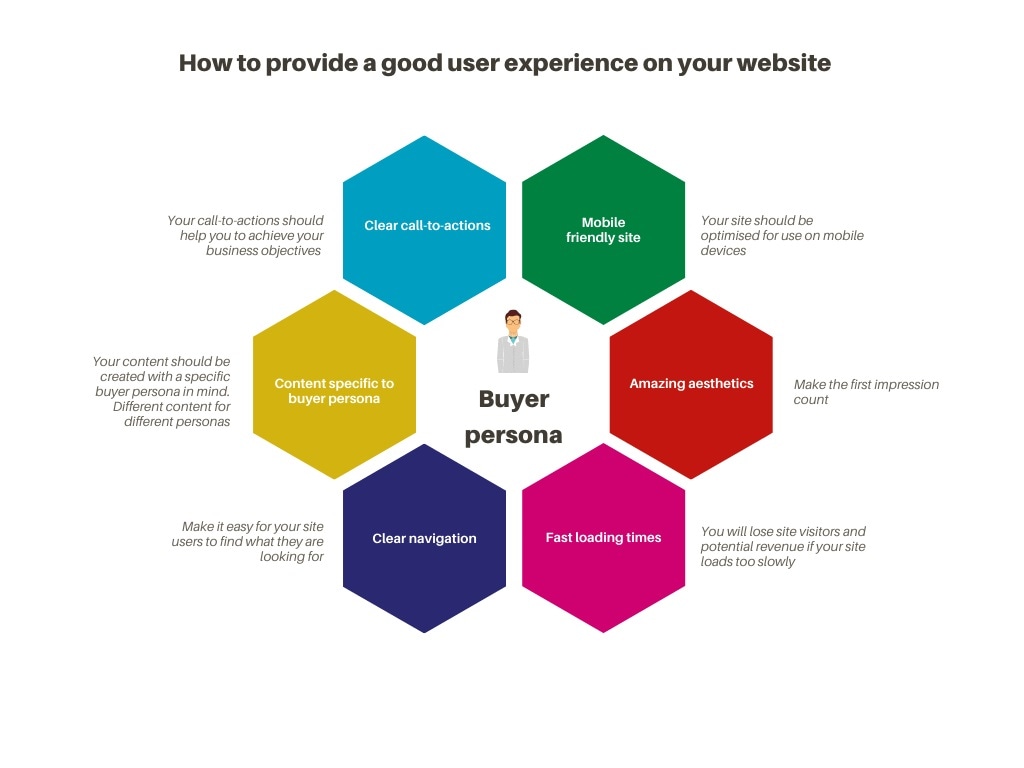
Providing a good user experience (UX) on your website can be the difference between meeting your business objectives and not.
Think back to the best and worst customer experience you have experienced at a shop, restaurant or event. How did that make you feel? Did it determine whether or not you spent your money there or elsewhere? Did it have a long-term impact on your attitude towards that organisation?
The impact that your website has on your site visitors is the same. If the experience doesn’t satisfy their needs on a practical and emotional level then chances are their impression of your site and your organisation will be negatively impacted for the foreseeable future.
What is user experience in web design?
User experience (or UX) in web design is a complicated term to define in full. However, to help us understand it better we can ask ourselves a simple question. How does your site visitor interact with your site?
We need to focus on creating a website that provides a positive experience, both practically (the user can find what they are looking for) and emotionally (the user feels good about your site).
Why is it important?
Think back to your experiences (good and bad) with brands in the past. The feelings you have will determine how much you are willing to spend on an organisation both in terms of time and money.
Your website is the mothership of your digital marketing efforts. It is where you educate your users through your blog, e-books, infographics etc. and where you inspire them through video, photos and testimonials.
Quite simply a bad experience can lead to loss of potential customers but a good one can not only lead to a sale but more importantly can help develop a long-term relationship that is beneficial to all parties.
Does your website currently provide a good user experience?
Monitoring your Google analytics over a period of time can help you to determine how your users are interacting with your site.
Keeping track of metrics such as time on page, bounce rates and exit pages will show you what is and isn’t working.
Read blog: Google Analytics - Key Marketing Metrics
But maybe the easiest way to see if you are currently providing a good user experience is to test it on a group of people that fit in with your buying personas.
Remember that chances are you and other members of your organisation interact and use your site on a regular basis so won’t be able to give an objective opinion of your site. Using people from outside your organisation will give you a much clearer idea of whether or not there are areas that require improvement.
What makes a good website user experience?
There are a number of key factors that make up a good website user experience. Below we look at some of the most important.

Generally, a website that is based on extensive research into your website users / potential users is the key to ensure that your site has great usability. But you can’t beat that first impression impact that a site with great aesthetics has on a user.
A positive first impression will start a positive user experience, help you to gain credibility with your user and begin to build trust with them
Great aesthetics provide the first impression that you are looking for but one of the fastest ways to undo that and lose people’s attention, interest and potential custom is a slow loading website.
Imagine there are 2 shops selling the same product. Both look great but one has a really long queue at the checkout and the other has multiple staff where you can pay without queuing. Chances are you are likely to go to second one – that is the same with a slow website. If pages take too long to load then your users are going to take their business elsewhere.
Don’t compromise on your site speed. Using amazing photos and video is great but ensure they are optimised so that they do not slow down your site.
According to the SEO expert Neil Patel 40% of people will abandon a site that takes more than 3 seconds to load.
Knowing and monitoring your site speed for desktop and mobile is key to ensuring that you aren’t losing out on potential customers or negatively impacted your brand.
This video below shows you how you can measure your site speed.
Google Page Speed Insights: https://developers.google.com/speed/pagespeed/insights/
HubSpot Website Grader: https://website.grader.com
Fast websites are a must so that your site visitors can easily and quickly navigate their way through your site.
Using site navigation that people are familiar with (logo in the left corner, navigation menu on the right etc.) is a good idea because it is so ingrained in us.
Some may argue that this can stunt your design efforts as some designers like to play around with the location of the navigation bar which is true to an extent. But whichever way you choose to go be sure that your site navigation is easy and logical.
Clear and easy to use navigation helps your users to find the information that they are looking for quickly which is the reason they came to your site in the first place.
- Content specific to your user
Understanding your different customers and their unique requirements is key to ensuring that you produce and publish the content that they want.
A user arrives on your website because they are looking for answers or solutions to their individual needs. Your content should provide these answers to your users and leave the pleased that they came to your site.
Doing this well will enable you to continue building the relationship with the user and encourage them to take further action that can start to move them into your sales funnel.
Your users will access your content in different ways so it is also critical to ensure that your site is optimised for use on mobile devices.
Google reports that over 50% of global internet traffic now comes from mobile. If your site doesn’t look and function correctly on mobile then you are potentially losing out on potential business.
KEY TIP: You can test if your site is mobile friendly by clicking this link and entering your URL: https://search.google.com/test/mobile-friendly
- Align your website with company goals
Finally, and perhaps most importantly, it is crucial that you align your website user experience with your business objectives.
What actions do your users need to take to help your meet your business objectives?
Your website should take your site visitors on a seamless journey that helps them find the information they require and inspires them to take an action that will help your business to grow.
How do you know if your tactics are working?
Measuring some of the key metrics that we have discussed previously over time including website speed, time on page, exit pages, bounce rates, conversions etc. is a good way of ensuring that your site is providing a positive user experience.
Another thing to consider is the questions that your organisation is being asked via the online chat, on the phone, by email etc. If the same questions are constantly coming up then there is an area on your site that you can improve.
There is also the option to use an extent intent popup. These appear on the screen when your user scrolls the mouse towards the top of their computer screen.
They can be used either to encourage users to stay on your site or ask them what they couldn’t find on your site today. These insights can be used to continue improving your website user experience going forward.
Finally observed testing can be used to see how a group of users interact with you site.
Conclusion
I hope this article has shown you that a positive user experience is vital in both the short and long term.
Being able to help your users find the information they require easily helps them in the short term and begins to build trust and authority that can lead to a positive long-term relationship between them and your organisation.
Getting this right can take time and money but getting it wrong is a cost your organisation cannot afford to make.
Get in touch with the team to arrange a free consultation about your organisations marketing.
Thanks for reading!